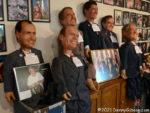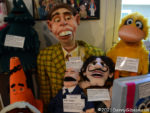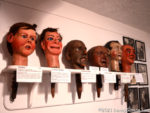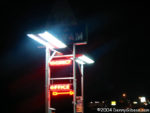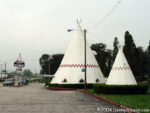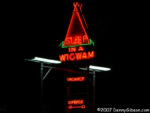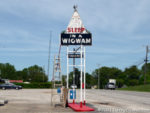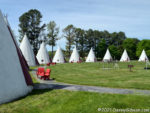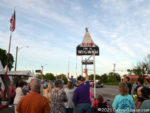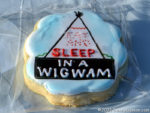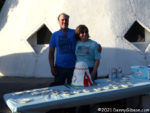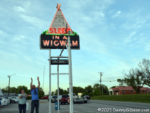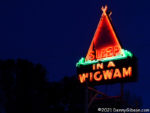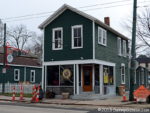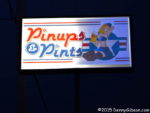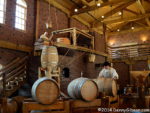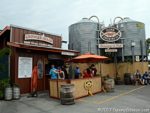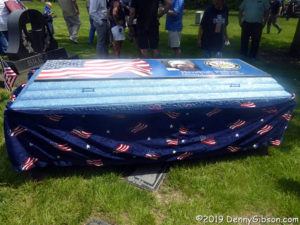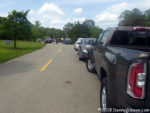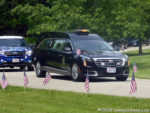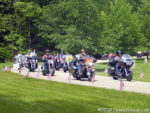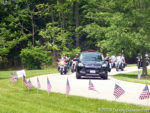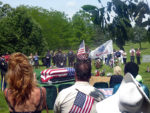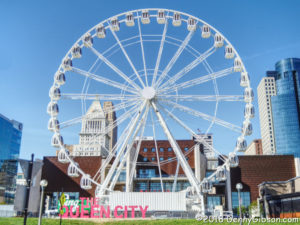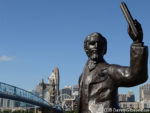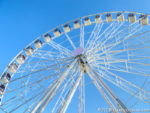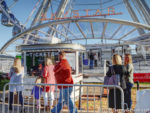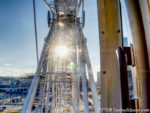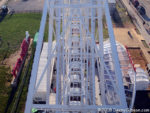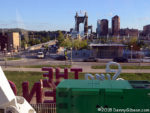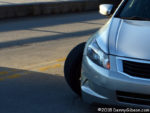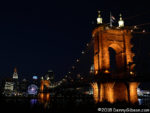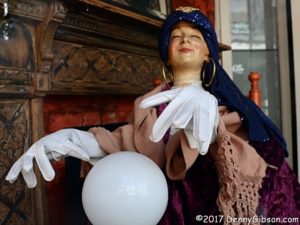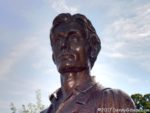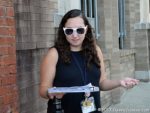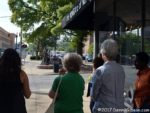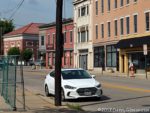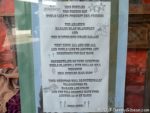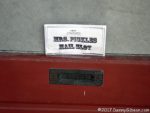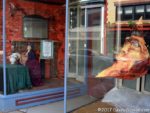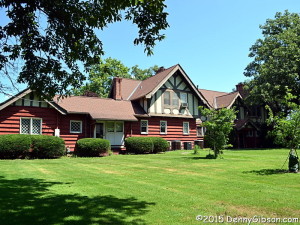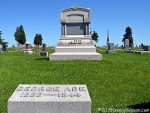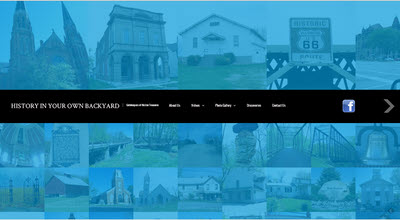 The town of Rising Sun, Northwest Territory, was laid out on the north bank of the Ohio River in 1814. A couple of years later, the area containing the town was included in the new state of Indiana. Folks were also settling on the south bank about that time, and a ferry operated in the vicinity as early as 1813 to connect the two communities. In 1831, a large building was constructed on the Kentucky side to store cargo before and after being transported on riverboats, and a small village called Carlton grew up around it. Eventually, Carlton became Rabbit Hash and that 1831 building became the Rabbit Hash General Store.
The town of Rising Sun, Northwest Territory, was laid out on the north bank of the Ohio River in 1814. A couple of years later, the area containing the town was included in the new state of Indiana. Folks were also settling on the south bank about that time, and a ferry operated in the vicinity as early as 1813 to connect the two communities. In 1831, a large building was constructed on the Kentucky side to store cargo before and after being transported on riverboats, and a small village called Carlton grew up around it. Eventually, Carlton became Rabbit Hash and that 1831 building became the Rabbit Hash General Store.
 A series of ferries operated here until 1945 when the Mildred was crushed by ice. The 73 year gap in service came to an end on September 29 when the MS Lucky Lady began carrying cars and people between Rising Sun and Rabbit Hash. I headed over to check it out on Tuesday and my first view of the new ferry is recorded in the opening picture which shows her leaving Kentucky. The picture at left shows her arriving in Indiana. I wasn’t ready to leave the state just yet so did not catch the next crossing. I would be back.
A series of ferries operated here until 1945 when the Mildred was crushed by ice. The 73 year gap in service came to an end on September 29 when the MS Lucky Lady began carrying cars and people between Rising Sun and Rabbit Hash. I headed over to check it out on Tuesday and my first view of the new ferry is recorded in the opening picture which shows her leaving Kentucky. The picture at left shows her arriving in Indiana. I wasn’t ready to leave the state just yet so did not catch the next crossing. I would be back.


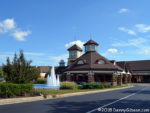 One of the things I wanted to do before departing Rising Sun was visit the Rising Star Casino. As many times as I’d visited and even stayed in Rising Sun, I had never been inside the casino. When it originally opened (as Grand Victoria) in 1996, the riverboat housing the casino was required to “cruise” so it hauled patrons a few hundred feet into the river and back on a regular schedule. Somewhere along the way, that requirement vanished. I passed through the building to which the boat is now permanently moored and onto the casino. It’s mostly slot machines with one area filled with some table games such as poker, roulette, and craps. The thing at least still looks like a boat and the top deck is accessible. On the far left of the third photo, the ferry (enlarged here) is approaching its Kentucky landing.
One of the things I wanted to do before departing Rising Sun was visit the Rising Star Casino. As many times as I’d visited and even stayed in Rising Sun, I had never been inside the casino. When it originally opened (as Grand Victoria) in 1996, the riverboat housing the casino was required to “cruise” so it hauled patrons a few hundred feet into the river and back on a regular schedule. Somewhere along the way, that requirement vanished. I passed through the building to which the boat is now permanently moored and onto the casino. It’s mostly slot machines with one area filled with some table games such as poker, roulette, and craps. The thing at least still looks like a boat and the top deck is accessible. On the far left of the third photo, the ferry (enlarged here) is approaching its Kentucky landing.


 Crossings at fifteen minute intervals are advertised and that seems about right to me. I snapped that first picture just as the ferry approached the dock. Capacity is ten cars and one of the crew told me they were pretty much at capacity throughout both of the two weekends they have been open. I saw loads of four to six today. I was the last of five cars to board for my trip, but they split the first four and put me front and center. A round trip costs $8. I traveled one-way for $5.
Crossings at fifteen minute intervals are advertised and that seems about right to me. I snapped that first picture just as the ferry approached the dock. Capacity is ten cars and one of the crew told me they were pretty much at capacity throughout both of the two weekends they have been open. I saw loads of four to six today. I was the last of five cars to board for my trip, but they split the first four and put me front and center. A round trip costs $8. I traveled one-way for $5.
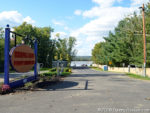 This is the Kentucky side dock with a decent sized staging area. The crew member I spoke with said that travel had been pretty steady in both directions with a slight edge to Indiana, i.e., casino, bound traffic. I’m sure that’s what was hoped for when Rising Star decided to spend $1.7 million on the ferry and access roads. Play at the casino can earn free ferry rides.
This is the Kentucky side dock with a decent sized staging area. The crew member I spoke with said that travel had been pretty steady in both directions with a slight edge to Indiana, i.e., casino, bound traffic. I’m sure that’s what was hoped for when Rising Star decided to spend $1.7 million on the ferry and access roads. Play at the casino can earn free ferry rides.

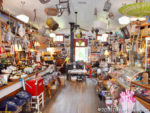
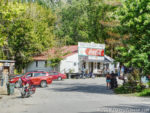 In February of 2016, that building erected in 1831 caught fire and burned to the ground. It was rebuilt using pieces of other old buildings in the exact image of itself. My comment on walking in the door was, “It’s like you never left.” It really wasn’t gone very long. It reopened in May of 2017, less than fifteen months after the fire. I visited Rabbit Hash twice while the rebuilding was in progress but this was my first time there after the reopening. It’s rather embarrassing to realize that it took me longer to get inside the new store than it took to build it. The rebuild is a phenomenal accomplishment in not just time but in attention to historic accuracy. The town has a fascinating history and a very interesting present. A lot about both can be learned at the Rabbit Hash General Store website.
In February of 2016, that building erected in 1831 caught fire and burned to the ground. It was rebuilt using pieces of other old buildings in the exact image of itself. My comment on walking in the door was, “It’s like you never left.” It really wasn’t gone very long. It reopened in May of 2017, less than fifteen months after the fire. I visited Rabbit Hash twice while the rebuilding was in progress but this was my first time there after the reopening. It’s rather embarrassing to realize that it took me longer to get inside the new store than it took to build it. The rebuild is a phenomenal accomplishment in not just time but in attention to historic accuracy. The town has a fascinating history and a very interesting present. A lot about both can be learned at the Rabbit Hash General Store website.
 The Rising Star Casino is quite visible from Rabbit Hash although the two are not directly across the river from each other. Rabbit Hash is directly across from the heart of Rising Sun. The ferry does not connect precisely to any of the three. The Indiana landing is just under a mile from the casino and the Kentucky landing is about a mile and a half from Rabbit Hash. That latter measurement is along the narrow Lower River Road. The road is well maintained but not wide enough to support heavy two way traffic. The signed route to and from the ferry is longer but safer.
The Rising Star Casino is quite visible from Rabbit Hash although the two are not directly across the river from each other. Rabbit Hash is directly across from the heart of Rising Sun. The ferry does not connect precisely to any of the three. The Indiana landing is just under a mile from the casino and the Kentucky landing is about a mile and a half from Rabbit Hash. That latter measurement is along the narrow Lower River Road. The road is well maintained but not wide enough to support heavy two way traffic. The signed route to and from the ferry is longer but safer.
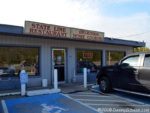 This is not associated in any way with the ferry or either of the towns it connects. It’s where I stopped for breakfast on the way to Rising Sun and I think it deserves a mention. The State Line Restaurant appeared in an online search and sounded interesting. It’s on US-50 on the Indiana side of the state line it is named after, and every bit as interesting as I’d hoped. The breakfast menu offered plenty of variety but listed a single “special” at the top. The special included goetta. Not “choice of goetta, bacon, or sausage”. Just goetta. No substitutions. That seemed significant and it was.
This is not associated in any way with the ferry or either of the towns it connects. It’s where I stopped for breakfast on the way to Rising Sun and I think it deserves a mention. The State Line Restaurant appeared in an online search and sounded interesting. It’s on US-50 on the Indiana side of the state line it is named after, and every bit as interesting as I’d hoped. The breakfast menu offered plenty of variety but listed a single “special” at the top. The special included goetta. Not “choice of goetta, bacon, or sausage”. Just goetta. No substitutions. That seemed significant and it was.
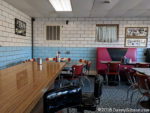 When I asked, my waitress said yes, they do make their own goetta. Goetta is an oatmeal and pork concoction served by most restaurants in the Cincinnati area but few make their own. Glier’s Goetta Company (formerly Glier’s Meats) has a near monopoly on the rest. The fact that the State Line Restaurant strongly featured the local breakfast staple told me it must be something special.
When I asked, my waitress said yes, they do make their own goetta. Goetta is an oatmeal and pork concoction served by most restaurants in the Cincinnati area but few make their own. Glier’s Goetta Company (formerly Glier’s Meats) has a near monopoly on the rest. The fact that the State Line Restaurant strongly featured the local breakfast staple told me it must be something special.
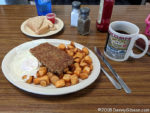 “It’s my grandfather’s recipe”, my waitress, who is also running the place at present, told me. The restaurant has been in operation since 1952. Her mother bought it twenty-two years ago. Mom is currently experiencing some health problems so the next generation is temporarily in charge. The State Line Special, minus an already downed glass of orange juice, is shown at left. It’s $7.50 including the coffee. In addition to the goetta, the excellent strawberry jam beside the toast is made on site. A tray of those little containers was being filled from a fresh batch at the other end of the counter. They also make their own blueberry jam and I was offered a sample to take with me but declined. Yes, I can be very stupid. I’ve already spent five days wondering if the blueberry jam is as good as the strawberry.
“It’s my grandfather’s recipe”, my waitress, who is also running the place at present, told me. The restaurant has been in operation since 1952. Her mother bought it twenty-two years ago. Mom is currently experiencing some health problems so the next generation is temporarily in charge. The State Line Special, minus an already downed glass of orange juice, is shown at left. It’s $7.50 including the coffee. In addition to the goetta, the excellent strawberry jam beside the toast is made on site. A tray of those little containers was being filled from a fresh batch at the other end of the counter. They also make their own blueberry jam and I was offered a sample to take with me but declined. Yes, I can be very stupid. I’ve already spent five days wondering if the blueberry jam is as good as the strawberry.
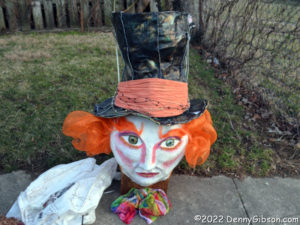 This is one of those embarrassing moments when I experience something for the first time that has been going on for years right under my nose and is so cool I should have been attending regularly. It’s the Mainstrasse Mardi Gras Parade in Covington, Kentucky. I’ve heard of Mardi Gras in Covington and possibly even heard there was a parade but I don’t remember. What I do remember is news reports about inebriated revelers trashing yards and peeing in bushes. It didn’t sound like a place I wanted to be. But this year I read about the parade with participants wearing gigantic papier-mâché heads and that very much sounded like something I wanted to see.
This is one of those embarrassing moments when I experience something for the first time that has been going on for years right under my nose and is so cool I should have been attending regularly. It’s the Mainstrasse Mardi Gras Parade in Covington, Kentucky. I’ve heard of Mardi Gras in Covington and possibly even heard there was a parade but I don’t remember. What I do remember is news reports about inebriated revelers trashing yards and peeing in bushes. It didn’t sound like a place I wanted to be. But this year I read about the parade with participants wearing gigantic papier-mâché heads and that very much sounded like something I wanted to see.
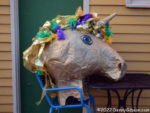
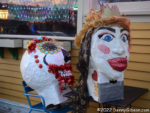 I reached the staging area with enough time to snap pictures of some of the big heads before they covered smaller heads.
I reached the staging area with enough time to snap pictures of some of the big heads before they covered smaller heads.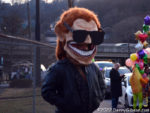
 Then got pictures of a few of those heads in place but not yet marching. I really don’t know just when this first began. One person I asked said, “At least ten years.” Another thought it started “around 2000”. I overheard someone telling a friend, “The last time I came down for this was twenty years ago”. I imagine I’ll eventually find something online that tells me, but not yet.
Then got pictures of a few of those heads in place but not yet marching. I really don’t know just when this first began. One person I asked said, “At least ten years.” Another thought it started “around 2000”. I overheard someone telling a friend, “The last time I came down for this was twenty years ago”. I imagine I’ll eventually find something online that tells me, but not yet.

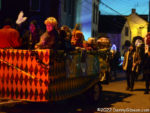 There were plenty of normal-sized heads in the parade and everybody was clearly having a lot of fun.
There were plenty of normal-sized heads in the parade and everybody was clearly having a lot of fun.
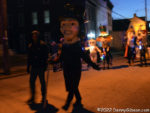
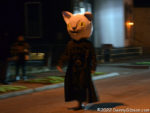 But it was the big heads that had gotten my attention and set the parade apart.
But it was the big heads that had gotten my attention and set the parade apart.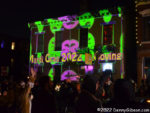 Most of the Mainstrasse restaurants and bars were fairly full before the parade started and became downright packed when it ended. Many had doormen posted to keep occupancy to legal levels. I moved away from the center of the festivities until I found a bar that was busy but not overcrowded and had one beer before heading home. I’ve absolutely nothing against partying in the streets for Mardi Gras but I’m too old and the street’s too cold.
Most of the Mainstrasse restaurants and bars were fairly full before the parade started and became downright packed when it ended. Many had doormen posted to keep occupancy to legal levels. I moved away from the center of the festivities until I found a bar that was busy but not overcrowded and had one beer before heading home. I’ve absolutely nothing against partying in the streets for Mardi Gras but I’m too old and the street’s too cold. 


